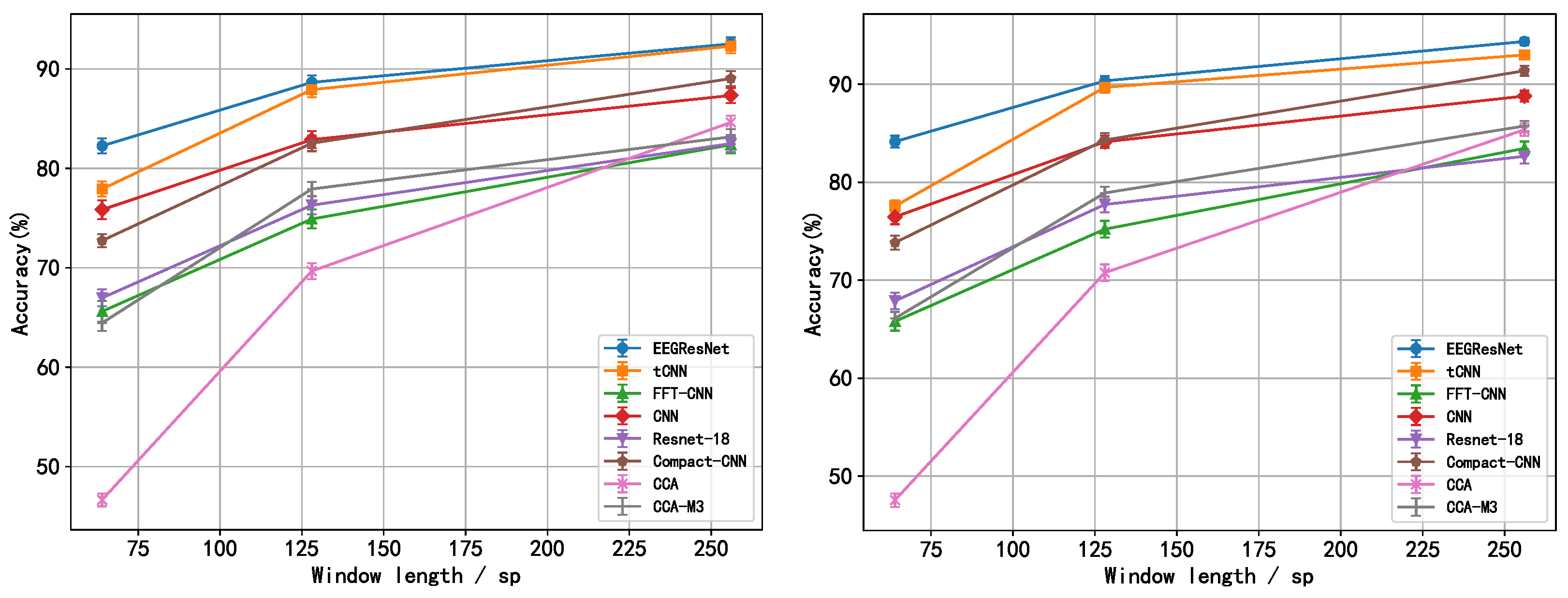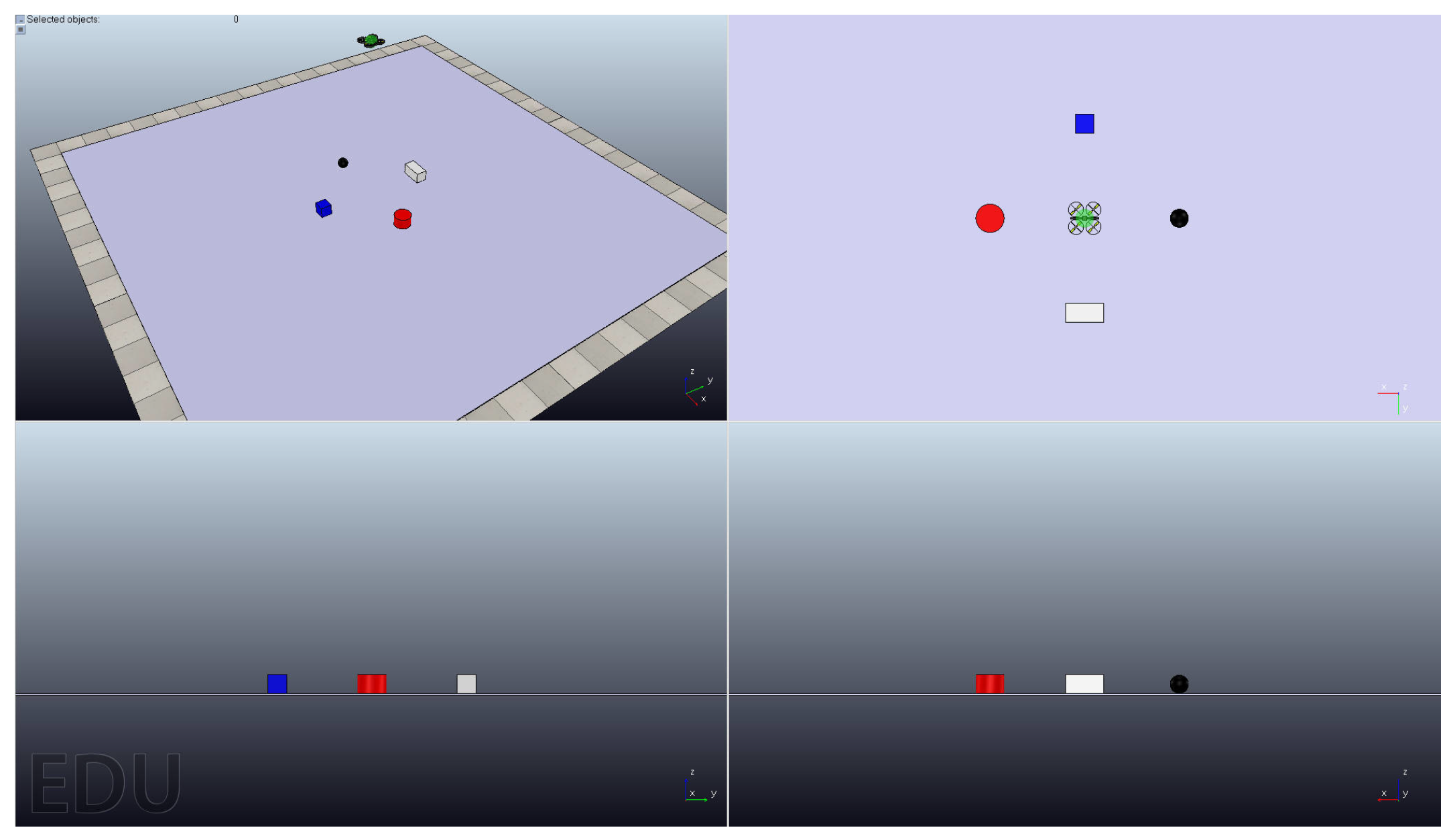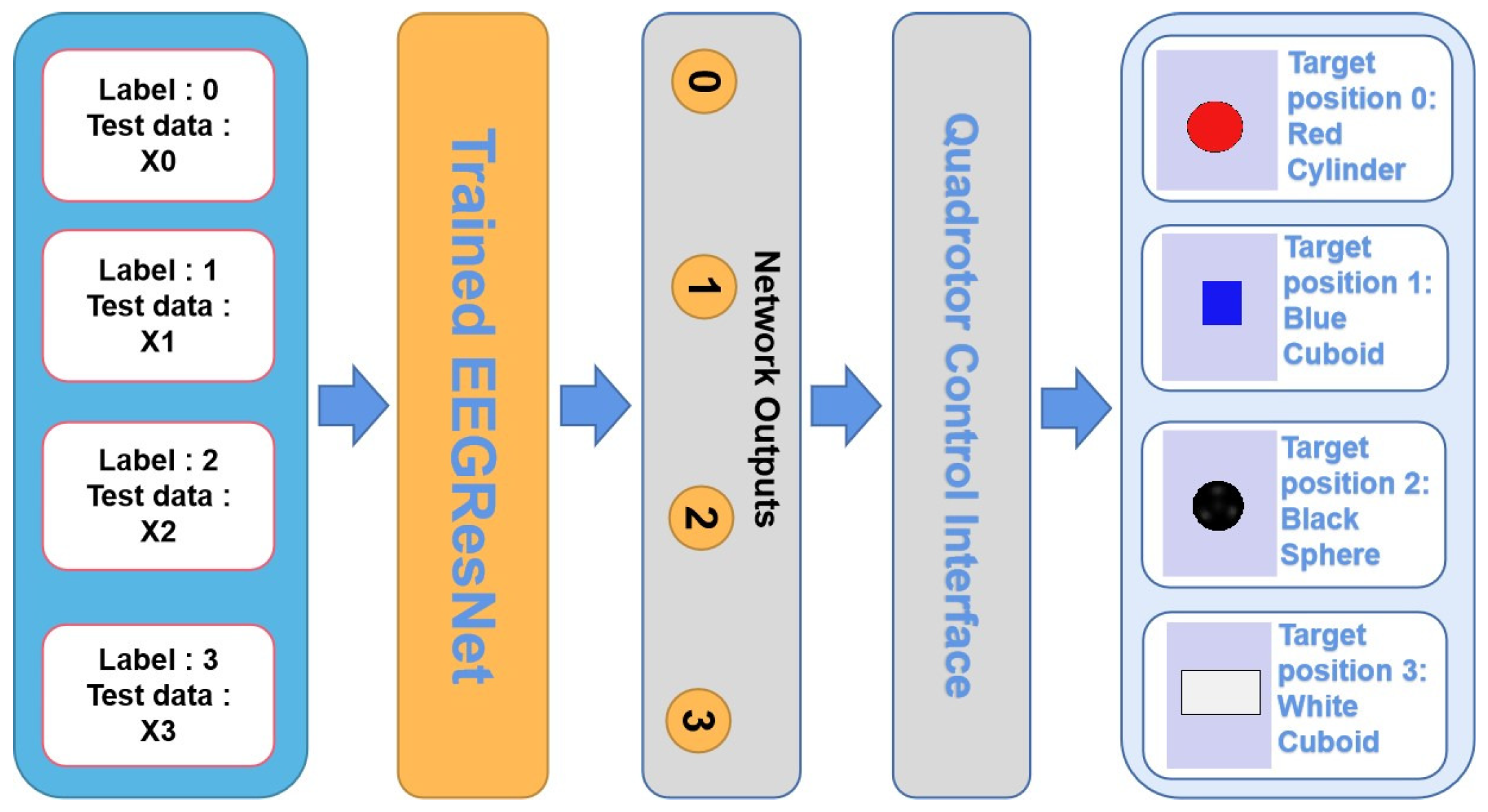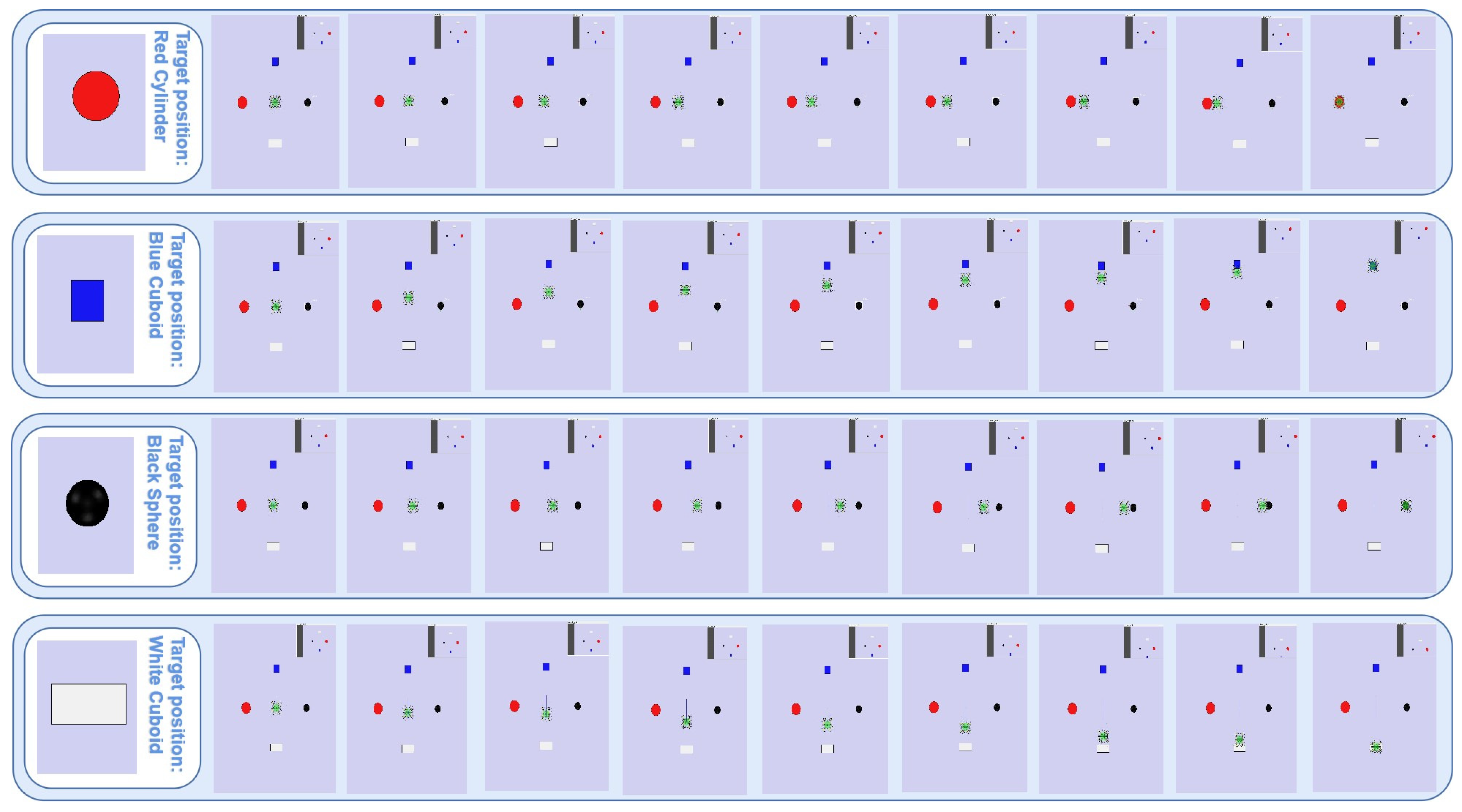Steady-State Visual-Evoked-Potential–Driven Quadrotor Control Using a Deep Residual CNN for Short-Time Signal Classification
Abstract
1. Introduction
- The network we designed has multiple CNN layers, so it has a strong feature learning ability. At the same time, the designed network makes use of ResNet’s residual connection skills; thus, it can automatically adjust the network structure according to the data characteristics.
- Our designed network was validated on two large public datasets [27]; thus, the results are highly persuasive. The results show that the EEGResNet specifically surpasses state-of-the-art methods in short-time-window analysis (64 sp, 128 sp, for example (sp: )).
- A BCI-based quadrotor control scheme is proposed, which demonstrates the potential of the designed network in practical applications. Because the shorter time window means the system identification lag time is shorter, it is easier to achieve the real-time control of the equipment.
2. Proposed Method
2.1. Public Dataset
2.2. Data Preprocessing
2.3. Network Structure
3. Experiment Results and Discussion
3.1. Training Processes
3.2. Baseline Networks
- CCA: [10] The SSVEP signal generated by the stimulus has a specific relationship with the target signal in the frequency domain. CCA identifies SSVEP signals by establishing this relationship.
- CCA-M3 [12]: The methods of CCA and CCA-M3 are similar, which are used to identify signals by establishing the relationship between SSVEP signal and another contrast signal. The only difference is that the contrast signal in the CCA-M3 method is composed of training data.
- FFT-CNN [22]: The FFT-CNN method firstly uses Fast Fourier Transform to extract frequency features, and then these frequency features are input into the CNN for feature learning to achieve signal identification.
- Compact-CNN [24]: The Compact-CNN is composed of CNN network layers and pooling layers. Unlike FFT-CNN, which requires frequency transformation, Compact-CNN uniquely employs raw time-domain signals as its input, eliminating preprocessing overhead.
- tCNN [28]: Similarly to the Compact-CNN, tCNN directly uses signals in the time domain as the input of the network. To simplify the network, tCNN removes the pooling layer in Compact-CNN.
- Resnet-18: It employs four stages of residual blocks, where short-cut connections directly add the input to the output within each block.
- CNN [23]: It serves as an end-to-end network architecture capable of directly classifying SSVEP stimuli from dry EEG waveforms without manual feature extraction.
3.3. Results
4. Application
4.1. Scenario Design
4.2. BCI-Based Control
5. Conclusions
Author Contributions
Funding
Conflicts of Interest
References
- Wolpaw, J.R.; Birbaumer, N.; McFarland, D.J.; Pfurtscheller, G.; Vaughan, T.M. Brain-computer interfaces for communication and control. Clin. Neurophysiol. 2002, 113, 767–791. [Google Scholar] [CrossRef] [PubMed]
- Lin, C.-T.; Do, T.-T.N. Direct-sense brain-computer interfaces and wearable computers. IEEE Trans. Syst. Man Cybern. Syst. 2021, 51, 298–312. [Google Scholar] [CrossRef]
- Kim, K.-T.; Suk, H.-I.; Lee, S.-W. Commanding a brain-controlled wheelchair using steady-state somatosensory evoked potentials. IEEE Trans. Neural Syst. Rehabil. Eng. 2018, 26, 654–665. [Google Scholar] [CrossRef]
- He, Y.; Eguren, D.; AzorAn, J.M.; Grossman, R.; Luu, T.P.; Contreras-Vidal, J.L.P. Brain-machine interfaces for controlling lower-limb powered robotic systems. J. Neural Eng. 2018, 15, 021004. [Google Scholar] [CrossRef]
- Ang, K.K.; Guan, C. Eeg-based strategies to detect motor imagery for control and rehabilitation. IEEE Trans. Neural Syst. Rehabil. Eng. 2017, 25, 392–401. [Google Scholar] [CrossRef]
- He, L.H.; Hu, D.; Wan, M.; Wen, Y.; von Deneen, K.M.; Zhou, M.C. Common Bayesian network for classification of EEG-based multiclass motor imagery BCI. IEEE Trans. Syst. Man Cybern. Syst. 2016, 46, 843–854. [Google Scholar] [CrossRef]
- Li, M.F.; Li, W.; Niu, L.W.; Zhou, H.H.; Chen, G.S.; Duan, F. An event-related potential-based adaptive model for telepresence control of humanoid robot motion in an environment cluttered with obstacles. IEEE Trans. Ind. Electron. 2017, 64, 1696–1705. [Google Scholar] [CrossRef]
- Gao, Z.; Zhang, K.; Dang, W.; Yang, Y.; Wang, Z.; Duan, H.; Chen, G. An adaptive optimal-kernel time-frequency representation-based complex network method for characterizing fatigued behavior using the SSVEP-based BCI system. Knowl.-Based Syst. 2018, 152, 163–171. [Google Scholar] [CrossRef]
- Yan, W.Q.; Xu, G.H.; Xie, J.; Li, M.; Dan, Z.Y. Four novel motion paradigms based on steady-state motion visual evoked potential. IEEE Trans. Biomed. Eng. 2018, 65, 1696–1704. [Google Scholar] [CrossRef] [PubMed]
- Lin, Z.; Zhang, C.; Wu, W.; Gao, X. Frequency recognition based on canonical correlation analysis for ssvep-based bcis. IEEE Trans. Biomed. Eng. 2006, 53, 2610–2614. [Google Scholar] [CrossRef] [PubMed]
- Bin, G.; Gao, X.; Wang, Y.; Li, Y.; Hong, B.; Gao, S. A high-speed bci based on code modulation vep. J. Neural Eng. 2011, 8, 025015. [Google Scholar] [CrossRef]
- Wei, Q.; Zhu, S.; Wang, Y.; Gao, X.; Guo, H.; Wu, X. A training data-driven canonical correlation analysis algorithm for designing spatial filters to enhance performance of ssvep-based bcis. Int. J. Neural Syst. 2020, 30, 2050020. [Google Scholar] [CrossRef]
- Chen, X.; Wang, Y.; Nakanishi, M.; Gao, X.; Jung, T.-P.; Gao, S. High-speed spelling with a noninvasive brain-computer interface. Proc. Natl. Acad. Sci. USA 2015, 112, E6058–E6067. [Google Scholar] [CrossRef] [PubMed]
- Chen, X.; Wang, Y.; Gao, S.; Jung, T.-P.; Gao, X. Filter bank canonical correlation analysis for implementing a high-speed ssvep-based braincomputer interface. J. Neural Eng. 2015, 12, 046008. [Google Scholar] [CrossRef]
- Simonyan, K.; Zisserman, A. Very deep convolutional networks for large-scale image recognition. arXiv 2014, arXiv:1409.1556. [Google Scholar]
- He, K.; Zhang, X.; Ren, S.; Sun, J. Deep residual learning for image recognition. In Proceedings of the IEEE Conference on Computer Vision and Pattern Recognition, Las Vegas, NV, USA, 27–30 June 2016; pp. 770–778. [Google Scholar]
- Mirowski, P.; Madhavan, D.; LeCun, Y.; Kuzniecky, R. Classification of patterns of eeg synchronization for seizure prediction. Clin. Neurophysiol. 2009, 120, 1927–1940. [Google Scholar] [CrossRef] [PubMed]
- Thodoroff, P.; Pineau, J.; Lim, A. Learning robust features using deep learning for automatic seizure detection. In Proceedings of the Machine Learning and Healthcare, Los Angeles, CA, USA, 19–20 August 2016; pp. 178–190. [Google Scholar]
- Gao, Z.; Yuan, T.; Zhou, X.; Ma, C.; Ma, K.; Hui, P. A deep learning method for improving the classification accuracy of SSMVEP-Based BCI. IEEE Trans. Circuits Syst. II Express Briefs 2020, 67, 3447–3451. [Google Scholar] [CrossRef]
- Li, D.; Chai, B.; Wang, Z.; Yang, H.; Du, W. EEG emotion recognition based on 3-D feature representation and dilated fully convolutional networks. IEEE Trans. Cogn. Dev. Syst. 2021, 13, 885–897. [Google Scholar] [CrossRef]
- Kwak, N.-S.; Muller, K.-R.; Lee, S.-W. A convolutional neural network for steady state visual evoked potential classification under ambulatory environment. PloS ONE 2017, 12, e0172578. [Google Scholar] [CrossRef]
- Zhang, X.; Xu, G.; Mou, X.; Ravi, A.; Li, M.; Wang, Y.; Jiang, N. A convolutional neural network for the detection of asynchronous steady state motion visual evoked potential. IEEE Trans. Neural Syst. Rehabil. Eng. 2019, 27, 1303–1311. [Google Scholar] [CrossRef]
- Aznan, N.K.N.; Bonner, S.; Connolly, J.; Moubayed, N.A.; Breckon, T. On the classification of ssvep-based dry-eeg signals via convolutional neural networks. In Proceedings of the 2018 IEEE International Conference on Systems, Man, and Cybernetics (SMC), Miyazaki, Japan, 7–10 October 2018; pp. 3726–3731. [Google Scholar]
- Waytowich, N.; Lawhern, V.J.; Garcia, J.O.; Cummings, J.; Faller, J.; Sajda, P.; Vettel, J.M. Compact convolutional neural networks for classification of asynchronous steady-state visual evoked potentials. J. Neural Eng. 2018, 15, 066031. [Google Scholar] [CrossRef] [PubMed]
- Manyakov, N.V.; Chumerin, N.; Robben, A.; Combaz, A.; Vliet, M.V.; Hulle, M.M.V. Sampled sinusoidal stimulation profile and multichannel fuzzy logic classification for monitor-based phase-coded ssvep braincomputer interfacing. J. Neural Eng. 2013, 10, 747–754. [Google Scholar] [CrossRef]
- Chen, X.; Chen, Z.; Gao, S.; Gao, X. A high-itr ssvep-based bci speller. Brain-Comput. Interfaces 2014, 1, 181–191. [Google Scholar] [CrossRef]
- Lee, M.-H.; Kwon, O.-Y.; Kim, Y.-J.; Kim, H.-K.; Lee, Y.-E.; Williamson, J.; Fazli, S.; Lee, S.-W. EEG dataset and openbmi toolbox for three bci paradigms: An investigation into bci illiteracy. GigaScience 2019, 8, giz002. [Google Scholar] [CrossRef] [PubMed]
- Ding, W.; Shan, J.; Fang, B.; Wang, C.; Sun, F.; Li, X. Filter bank convolutional neural network for short time-window steady-state visual evoked potential classification. IEEE Trans. Neural Syst. Rehabil. Eng. 2021, 29, 2615–2624. [Google Scholar] [CrossRef] [PubMed]






| Method | Session01 | Session02 | ||
|---|---|---|---|---|
| Mean/std | F1/std | Mean/std | F1/std | |
| FFT-CNN | 65.62/2.05 | 67.99/1.89 | 65.80/1.92 | 68.06/1.78 |
| Compact-CNN | 72.74/1.70 | 73.55/1.67 | 73.84/1.43 | 74.62/1.43 |
| tCNN | 76.34/1.64 | 77.93/1.51 | 77.56/1.38 | 79.10/1.26 |
| Resnet-18 | 66.98/1.94 | 69.23/1.81 | 67.89/1.79 | 69.26/1.68 |
| CNN | 75.85/1.78 | 77.60/1.66 | 76.47/1.54 | 78.27/1.41 |
| CCA | 46.66/1.28 | 42.55/– | 47.55/1.36 | 32.75/– |
| CCA-M3 | 64.44/1.60 | 74.27/– | 66.11/1.41 | 68.15/– |
| EEGResNet (Ours) | 82.27/1.56 | 83.55/1.44 | 84.15/1.24 | 85.39/1.14 |
| Classes | Metrics | FFT-CNN | Compact-CNN | tCNN | Resnet-18 | CNN | CCA | CCA-M3 | Ours |
|---|---|---|---|---|---|---|---|---|---|
| Sensitivity | 71.97 | 86.19 | 79.73 | 71.35 | 78.19 | 37.50 | 76.92 | 83.54 | |
| Class 1 | Specificity | 90.48 | 90.60 | 94.75 | 90.93 | 93.25 | 97.37 | 90.24 | 95.92 |
| F1-score | 71.77 | 79.94 | 81.50 | 71.99 | 78.88 | 52.17 | 74.07 | 85.29 | |
| Sensitivity | 68.47 | 72.35 | 78.71 | 71.78 | 77.80 | 25.00 | 62.50 | 84.16 | |
| Class 2 | Specificity | 90.10 | 95.01 | 95.37 | 89.42 | 94.80 | 84.21 | 94.74 | 96.20 |
| F1-score | 69.09 | 77.25 | 81.75 | 70.66 | 80.41 | 30.77 | 71.43 | 86.11 | |
| Sensitivity | 62.32 | 77.11 | 72.98 | 63.71 | 74.02 | 28.57 | 78.57 | 78.75 | |
| Class 3 | Specificity | 87.98 | 83.74 | 91.81 | 88.29 | 92.00 | 91.49 | 87.50 | 94.36 |
| F1-score | 62.82 | 68.67 | 73.91 | 63.86 | 74.75 | 30.77 | 73.33 | 80.50 | |
| Sensitivity | 59.95 | 51.65 | 74.98 | 61.30 | 73.88 | 86.67 | 81.82 | 81.57 | |
| Class 4 | Specificity | 85.68 | 92.85 | 86.86 | 87.47 | 87.93 | 53.85 | 93.02 | 89.52 |
| F1-score | 59.10 | 59.78 | 69.98 | 61.58 | 70.30 | 56.52 | 78.26 | 76.61 |
| Classes | Metrics | FFT-CNN | Compact-CNN | tCNN | Resnet-18 | CNN | CCA | CCA-M3 | Ours |
|---|---|---|---|---|---|---|---|---|---|
| Sensitivity | 71.63 | 86.29 | 82.96 | 74.20 | 80.19 | 00.00 | 89.47 | 86.32 | |
| Class 1 | Specificity | 90.79 | 96.46 | 94.31 | 91.15 | 93.19 | 93.18 | 82.86 | 95.84 |
| F1-score | 71.97 | 87.74 | 82.94 | 74.06 | 80.00 | 00.00 | 80.95 | 86.86 | |
| Sensitivity | 69.70 | 83.57 | 81.16 | 71.48 | 78.86 | 44.44 | 60.00 | 85.75 | |
| Class 2 | Specificity | 90.41 | 93.90 | 95.38 | 91.06 | 95.36 | 1.00 | 95.45 | 97.08 |
| F1-score | 70.23 | 82.73 | 83.31 | 72.12 | 81.83 | 61.54 | 66.67 | 88.22 | |
| Sensitivity | 60.73 | 80.03 | 72.85 | 63.64 | 74.21 | 33.33 | 66.67 | 81.75 | |
| Class 3 | Specificity | 88.35 | 90.15 | 92.43 | 88.43 | 92.45 | 76.92 | 90.48 | 95.08 |
| F1-score | 62.00 | 76.54 | 74.43 | 64.02 | 75.36 | 34.48 | 66.67 | 83.07 | |
| Sensitivity | 61.68 | 67.41 | 75.38 | 62.89 | 75.03 | 63.64 | 53.85 | 83.65 | |
| Class 4 | Specificity | 85.05 | 92.04 | 88.71 | 86.81 | 88.45 | 48.84 | 90.24 | 91.08 |
| F1-score | 59.74 | 70.25 | 71.98 | 62.09 | 71.50 | 35.00 | 58.33 | 79.69 |
Disclaimer/Publisher’s Note: The statements, opinions and data contained in all publications are solely those of the individual author(s) and contributor(s) and not of MDPI and/or the editor(s). MDPI and/or the editor(s) disclaim responsibility for any injury to people or property resulting from any ideas, methods, instructions or products referred to in the content. |
© 2025 by the authors. Licensee MDPI, Basel, Switzerland. This article is an open access article distributed under the terms and conditions of the Creative Commons Attribution (CC BY) license (https://creativecommons.org/licenses/by/4.0/).
Share and Cite
Chen, J.; Yang, C.; Wei, R.; Hua, C.; Mu, D.; Sun, F. Steady-State Visual-Evoked-Potential–Driven Quadrotor Control Using a Deep Residual CNN for Short-Time Signal Classification. Sensors 2025, 25, 4779. https://doi.org/10.3390/s25154779
Chen J, Yang C, Wei R, Hua C, Mu D, Sun F. Steady-State Visual-Evoked-Potential–Driven Quadrotor Control Using a Deep Residual CNN for Short-Time Signal Classification. Sensors. 2025; 25(15):4779. https://doi.org/10.3390/s25154779
Chicago/Turabian StyleChen, Jiannan, Chenju Yang, Rao Wei, Changchun Hua, Dianrui Mu, and Fuchun Sun. 2025. "Steady-State Visual-Evoked-Potential–Driven Quadrotor Control Using a Deep Residual CNN for Short-Time Signal Classification" Sensors 25, no. 15: 4779. https://doi.org/10.3390/s25154779
APA StyleChen, J., Yang, C., Wei, R., Hua, C., Mu, D., & Sun, F. (2025). Steady-State Visual-Evoked-Potential–Driven Quadrotor Control Using a Deep Residual CNN for Short-Time Signal Classification. Sensors, 25(15), 4779. https://doi.org/10.3390/s25154779






